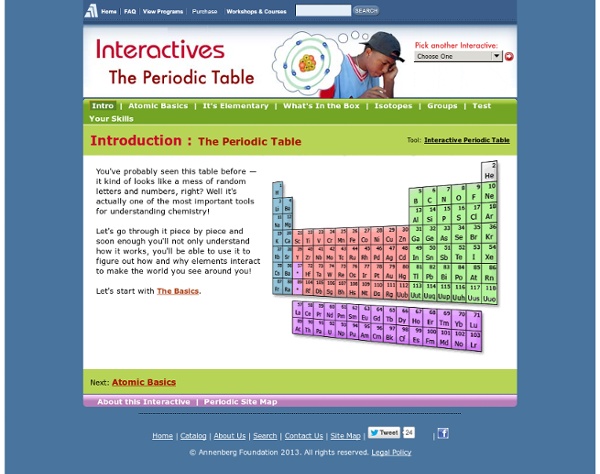



http://www.learner.org/interactives/periodic/index.html
Related: Kemi50 Awesome Chemistry Videos For The Busy Science Teacher Though we don’t often recognize it, chemistry defines nearly every element of our everyday lives. From the reactions that fuel the sun to the biology of our bodies to the technology in our gadgets, chemistry is at the heart of everything we do and is the central science that unites biology, physics, geology, astronomy, medicine, and countless other fields. Yet chemistry doesn’t always get the credit and recognition it deserves for playing such an awesome role in, well, everything. If you’ve been slighting chemistry, there’s no better time to give the field the credit it deserves than National Chemistry Week. Founded in 1987, the week-long event has helped bring awareness to the role chemistry plays both in our lives today and in our future. You can get in the spirit of the event by checking out a few (or all) of these amazing chemistry videos online.
When an artist looks at a chemical element, what do they see? Artistic depictions of several chemical elements feature in a new exhibition from today as part of Australia’s celebrations for the International Year of the Periodic Table. They are the work of artists Damon Kowarsky and Hyunju Kim, who worked together since December 2018 on the renditions that will be on display at Quantum Victoria, a specialist science and mathematics centre in the northern suburbs of Melbourne. The project followed a chance meeting between Damon and Soula Bennett, the director of Quantum Victoria. Soula believes Science, Technology, Engineering and Mathematics (STEM) naturally extend to incorporate art. Read more: The periodic table: from its classic design to use in popular culture So Damon and Kim were commissioned to produce a series of 51 artistic interpretations illustrating elements of significance in the story of the birth of the universe from the Periodic Table.
Stellarium Var ifrån kommer näringsämnena i maten? - kemi årskurs 1-3 - undervisningsstöd Elever som är intresserade av var ämnena i maten kommer ifrån kan till exempel vilja arbeta med följande frågor. Vilka livsmedel kommer från växter och vilka kommer från djur? Vilka näringskedjor äter vi ifrån? Diskutera The Elements According to Relative Abundance The Elements According to Relative Abundance A Periodic Chart by Prof Wm. F Sheehan, University of Santa Clara.CA 95053 Högstadiekemi - Naturvetenskap.org Välkommen till högstadiekemin! I den här avdelningen samlar vi de artiklar som vi tänker oss ska passa för högstadieelever, men också för den som behöver repetera grunderna från högstadiet, eller helt enkelt bara vill lära sig mer om hur kemin runtomkring oss fungerar. Oavsett vilket, är tanken att informationen här ska vara lätt att ta till sig, utan att det ska behövas några speciellt stora förkunskaper. Det är viktigt att förstå att det primära syftet inte är att artiklarna ska fungera som ett alternativ till vanlig undervisning och traditionella läromedel, utan snarare som ett komplement.
Periodic Table of the Elements by WebElements Matens kemi - undervisningsstöd Matens kemi är ett förslag på hur ett arbetsområde inom kemi kan organiseras. Arbetsområdet har sin utgångspunkt i förmågan att använda kunskaper i kemi för att granska information, kommunicera och ta ställning i frågor som rör energi, miljö, hälsa och samhälle. Elevernas uppgift är att göra ett populärvetenskapligt uppslag om mat i en tidning för jämnåriga. Elements 4D by DAQRI LÄTT ATT LÄRA! - Kemi Under uppbyggnad. Kom snart tillbaka :)! Men om du vill kan du klicka på länkarna som finns nedan redan nu. Snart är denna sida snygg och lättmanövrerad. Block 1: Kemins grunder och fingeravtrycksanalyser Inledning I denna första del i block 1 får du information om kemins historia, atommodellen samt materia. Förmodligen (eller förhoppningsvis!) känner du igen det mesta från grundskolan. De två första undervisningsfilmerna är gjorda av Magnus Ehinger som är giganten på youtube när det gäller undervisningsfilmer i kemi. Magnus introducerar dig till kemins historia och förklarar hur den nuvarande atommodellen har växt fram genom olika experiment som kända kemister har genomfört.
Lab.handledningar år 7-9 Sidor Lab.handledningar år 7-9 Mallar: Hur man skriver en lab.rapport, vad som bedöms och bedömda elevrapporter. (Ta egen kopia av filen) Hur man skriver en bra diskussionLär av gamla provLaborationshandledningar till laborationer som ev. används under år 7-9:Intro:✩Enkla separationer✩Tillverka tandkräm Läppcerat Läppstift ✩Vad kan man göra för att undvika att det svider i ögonen när man skalar lök?